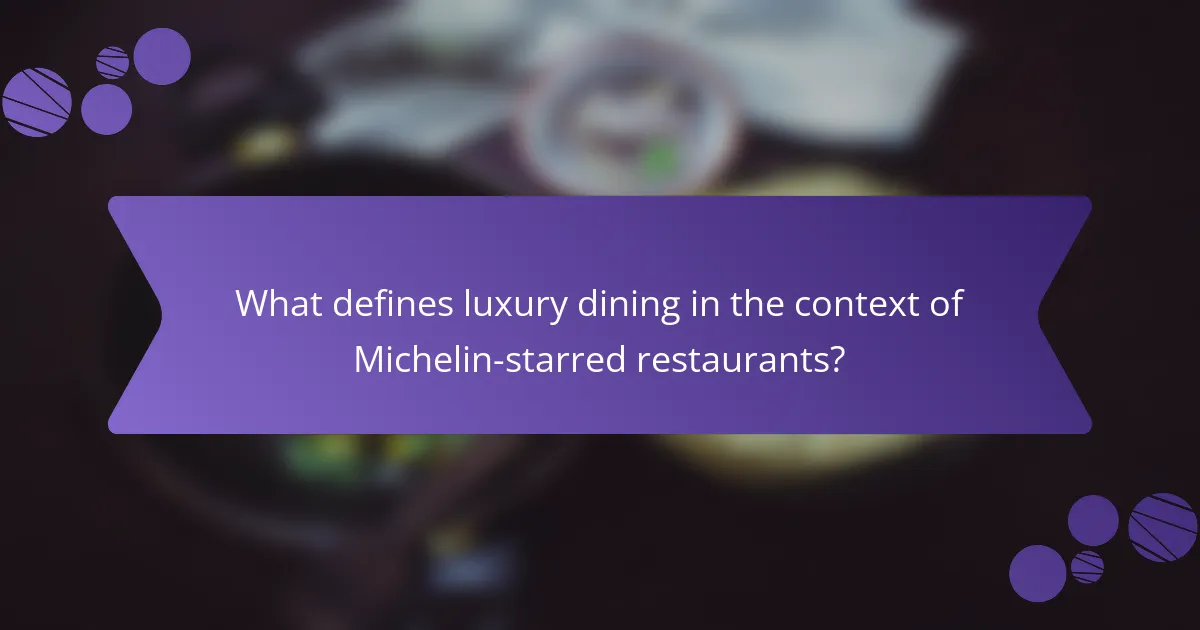
What defines luxury dining in the context of Michelin-starred restaurants?
Luxury dining in Michelin-starred restaurants is defined by exceptional quality, service, and ambiance. These establishments offer meticulously crafted dishes made from the finest ingredients. Each dish often showcases innovative techniques and artistic presentation. The dining experience is enhanced by highly trained staff providing personalized service. Atmosphere plays a crucial role, with elegant decor and attention to detail. Michelin stars are awarded based on rigorous criteria, including consistency and creativity. The exclusivity of reservations adds to the luxury experience. Overall, Michelin-starred dining represents the pinnacle of culinary excellence.
How do Michelin stars influence the perception of a restaurant?
Michelin stars significantly enhance the perception of a restaurant. Restaurants with Michelin stars are often viewed as high-quality establishments. The rating serves as a benchmark for culinary excellence. Consumers associate Michelin stars with superior food, service, and ambiance. This association can lead to increased customer interest and foot traffic. Studies show that Michelin-starred restaurants often experience a boost in reservations following a star rating. Additionally, the prestige of Michelin stars can elevate a restaurant’s status in the competitive dining market. Thus, the influence of Michelin stars is profound and multifaceted.
What criteria are used to award Michelin stars?
Michelin stars are awarded based on several key criteria. Inspectors evaluate the quality of ingredients used in a dish. They assess the skill in the preparation and cooking techniques. The harmony of flavors is also a critical factor. Consistency across the menu and during multiple visits is essential. The overall dining experience, including service and ambiance, is considered. Michelin’s anonymous inspectors apply these criteria rigorously to maintain standards. The system has been in place since the early 20th century, ensuring credibility and prestige.
How does the Michelin rating system impact customer expectations?
The Michelin rating system significantly raises customer expectations for dining experiences. A Michelin star indicates exceptional quality and culinary excellence. Customers often expect innovative dishes and high service standards at starred restaurants. The presence of a star can create a perception of exclusivity and prestige. Many diners anticipate a memorable experience that justifies the higher prices. Research shows that restaurants with Michelin stars often see increased reservations and customer interest. This system influences diners’ choices and expectations before they even enter the establishment. Ultimately, the Michelin rating shapes the luxury dining landscape by setting high benchmarks for quality.
What are the key characteristics of exclusive restaurants?
Exclusive restaurants are characterized by high-quality cuisine, exceptional service, and a luxurious ambiance. These establishments often feature Michelin-starred chefs known for their culinary expertise. They typically offer a limited and meticulously crafted menu that highlights seasonal and premium ingredients. Exclusive restaurants prioritize privacy and intimacy, often providing secluded seating arrangements. Reservations are usually required, sometimes weeks in advance, to ensure a personalized experience. The décor is often elegant, with attention to detail in both design and presentation. Exclusive restaurants may also offer unique dining experiences, such as chef’s tables or tasting menus. Overall, these characteristics contribute to a distinctive and memorable dining experience.
How do ambiance and service contribute to the luxury dining experience?
Ambiance and service are critical elements that enhance the luxury dining experience. A well-designed ambiance sets the tone for the meal. It includes factors like lighting, decor, and music. These elements create an inviting and comfortable environment. Studies show that a pleasant atmosphere can elevate diners’ overall satisfaction.
Service plays a pivotal role in luxury dining. Attentive and knowledgeable staff contribute to a seamless experience. They enhance the meal with personalized recommendations and timely service. Research indicates that high-quality service can significantly impact customers’ perceptions of value. Together, ambiance and service create a memorable dining experience that exceeds expectations.
What role do location and accessibility play in exclusivity?
Location and accessibility significantly influence exclusivity in luxury dining. Exclusive restaurants often occupy prestigious or remote locations. This geographical positioning enhances their allure and perceived value. Accessibility also plays a crucial role; limited access can create a sense of rarity. For example, a restaurant located in a secluded area may attract diners seeking unique experiences. Additionally, high-profile locations can elevate a restaurant’s status. Proximity to luxury hotels or landmarks often correlates with higher demand. Therefore, both factors contribute to the overall exclusivity of a dining establishment.

What makes a chef Michelin-starred?
A chef becomes Michelin-starred through exceptional culinary skill and consistent high-quality food. Michelin stars are awarded based on criteria such as the quality of ingredients, mastery of techniques, and the harmony of flavors. The Michelin Guide employs anonymous inspectors to evaluate restaurants. These inspectors assess the overall dining experience, including service and ambiance. A chef must consistently deliver outstanding dishes to maintain their star status. Michelin stars can range from one to three, with three being the highest honor. Achieving a star can significantly elevate a chef’s career and restaurant reputation.
How does a chef achieve Michelin-star status?
A chef achieves Michelin-star status by consistently delivering exceptional culinary experiences. This includes high-quality ingredients, innovative techniques, and exquisite presentation. The Michelin Guide evaluates restaurants based on five criteria: quality of ingredients, mastery of flavor and cooking techniques, the personality of the chef in the cuisine, value for money, and consistency.
Restaurants are anonymously inspected by Michelin inspectors. They assess the dining experience over multiple visits. A restaurant can earn one to three stars. One star indicates a very good restaurant, two stars signify excellent cooking, and three stars represent exceptional cuisine worth a special journey.
The Michelin Guide has a long history, dating back to 1900. It began as a travel guide in France and evolved into a prestigious restaurant rating system. Achieving Michelin-star status is a significant honor in the culinary world. It often leads to increased visibility and business for the restaurant.
What skills and experience are necessary for Michelin-starred chefs?
Michelin-starred chefs require a combination of culinary skills and extensive experience. Mastery in cooking techniques is essential. This includes proficiency in knife skills, sauce preparation, and cooking methods. Knowledge of flavor profiles and ingredient pairings is also crucial. Michelin-starred chefs typically have years of experience in high-pressure kitchen environments. Many have trained under renowned chefs or attended prestigious culinary schools.
Creativity is a key attribute for developing unique dishes. Attention to detail ensures high standards in presentation and taste. Strong leadership and communication skills are necessary for managing kitchen staff. Michelin-starred chefs often have experience with menu development and food sourcing. These combined skills and experiences contribute to achieving and maintaining Michelin star ratings.
How does a chef’s culinary philosophy influence their Michelin rating?
A chef’s culinary philosophy significantly influences their Michelin rating by shaping the overall dining experience. This philosophy dictates the approach to ingredients, techniques, and presentation. For instance, a chef who emphasizes local sourcing may create dishes that reflect regional flavors, appealing to Michelin inspectors. Additionally, innovation in culinary techniques can lead to unique menu offerings, which are often rewarded by Michelin. Consistency in executing this philosophy is crucial; Michelin inspectors value reliability in quality. The alignment of a chef’s vision with the restaurant’s ambiance and service also plays a role. Ultimately, a well-defined culinary philosophy can elevate a restaurant’s standing, leading to higher Michelin ratings.
What are signature dishes and why are they important?
Signature dishes are unique culinary creations that represent a chef’s style or a restaurant’s identity. They often highlight specific ingredients or techniques that set them apart. Signature dishes are important because they create a distinctive dining experience. They attract customers seeking something special and memorable. These dishes can enhance a restaurant’s reputation and contribute to its brand identity. For example, a Michelin-starred chef may have a signature dish that showcases their culinary innovation. This can lead to increased media attention and customer loyalty. Ultimately, signature dishes play a crucial role in the luxury dining landscape by offering exclusivity and a sense of artistry.
How do signature dishes reflect a chef’s style and creativity?
Signature dishes embody a chef’s unique style and creativity through distinctive flavors and techniques. These dishes often showcase the chef’s personal culinary philosophy. They reflect innovation, combining traditional elements with modern interpretations. Signature dishes may highlight regional ingredients, emphasizing the chef’s connection to their culinary roots. The presentation of these dishes also reveals artistic flair, demonstrating attention to detail. Furthermore, signature dishes often become a restaurant’s hallmark, attracting patrons seeking a memorable dining experience. This connection between dish and chef establishes a brand identity that resonates with diners. Overall, signature dishes serve as a canvas for chefs to express their individuality and culinary vision.
What ingredients are commonly found in signature dishes at Michelin-starred restaurants?
Signature dishes at Michelin-starred restaurants often include high-quality ingredients such as truffles, foie gras, and fresh seafood. These ingredients are prized for their unique flavors and textures. Truffles add an earthy aroma and depth to dishes. Foie gras provides a rich, buttery taste that elevates the dining experience. Fresh seafood, such as scallops and lobster, offers a delicate and refined flavor profile. Seasonal vegetables are also commonly featured, emphasizing freshness and local sourcing. Herbs like saffron and microgreens enhance presentation and flavor complexity. These ingredients contribute to the overall artistry and innovation in Michelin-starred cuisine.

How do exclusive dining experiences vary across different cultures?
Exclusive dining experiences vary significantly across different cultures. In Japan, kaiseki dining emphasizes seasonal ingredients and meticulous presentation. French cuisine often features multi-course meals with a focus on technique and pairing wines. In contrast, Ethiopian dining encourages communal eating with injera, a sourdough flatbread, serving as a base for various stews. Chinese fine dining highlights elaborate banquets with a focus on balance and harmony of flavors. Each culture incorporates unique customs, such as the Japanese tea ceremony or the Italian tradition of leisurely meals. These differences reflect local ingredients, historical influences, and social customs.
What are some examples of luxury dining in different countries?
Examples of luxury dining in different countries include Noma in Denmark, known for its innovative Nordic cuisine. In France, Le Meurice offers a classic French fine dining experience with a three-Michelin-star rating. Italy’s Osteria Francescana is celebrated for its contemporary Italian dishes and has also received three Michelin stars. In Japan, Sukiyabashi Jiro is famous for its exquisite sushi and has been awarded three Michelin stars. Spain’s El Celler de Can Roca is renowned for its creative Catalan cuisine and has received three Michelin stars. Each of these restaurants showcases unique culinary artistry and exceptional service, reflecting the luxury dining experience in their respective countries.
How do cultural influences shape the menu at Michelin-starred restaurants?
Cultural influences significantly shape the menu at Michelin-starred restaurants. These restaurants often reflect local traditions, ingredients, and cooking techniques. Chefs incorporate regional flavors to create unique culinary experiences. For instance, a French restaurant may use Japanese umami elements to enhance traditional dishes. The menu can also showcase seasonal and local produce, aligning with cultural practices of sustainability. Michelin-starred chefs often travel and study global cuisines, integrating diverse influences into their menus. This blending of cultures can lead to innovative dishes that appeal to a broad audience. Furthermore, cultural narratives and stories behind dishes can enhance the dining experience, making it more memorable for patrons.
What trends are emerging in luxury dining today?
Emerging trends in luxury dining today include a focus on sustainability and locally sourced ingredients. Many high-end restaurants are prioritizing organic produce and ethically raised meats. This shift reflects growing consumer demand for transparency in food sourcing. Furthermore, experiential dining is gaining popularity, where the atmosphere and service enhance the meal. Interactive elements, such as chef’s tables or cooking classes, are becoming more common. Technology integration is also notable, with digital menus and contactless payments enhancing convenience. Additionally, there is a rise in plant-based and alternative protein options on luxury menus. This trend caters to health-conscious diners and those with dietary restrictions. Overall, these trends indicate a significant evolution in the luxury dining landscape.
How is sustainability impacting Michelin-starred restaurants?
Sustainability is significantly impacting Michelin-starred restaurants by driving changes in sourcing, menu design, and operational practices. Many Michelin-starred chefs are prioritizing local and seasonal ingredients. This shift reduces carbon footprints and supports local economies. Restaurants are also adopting waste reduction strategies, such as composting and recycling. Studies show that sustainable practices can enhance a restaurant’s reputation and customer loyalty. For instance, a survey revealed that 70% of diners prefer restaurants with sustainable practices. Additionally, Michelin has introduced a sustainability award to recognize restaurants excelling in these efforts. This recognition encourages more establishments to adopt eco-friendly practices. Overall, sustainability is reshaping the luxury dining landscape, aligning it with modern consumer values.
What role does technology play in the evolution of luxury dining?
Technology enhances luxury dining by improving service efficiency and guest experiences. Automation in kitchens allows chefs to focus on creativity while maintaining high-quality standards. Reservation systems utilize AI to optimize table management and wait times. Mobile apps enable personalized dining experiences through tailored menus and preferences. Virtual reality can create immersive dining environments. Data analytics helps restaurants understand customer preferences and trends. Contactless payments streamline transactions, enhancing convenience. Overall, technology transforms luxury dining into a more engaging and efficient experience.
What should diners expect when visiting a Michelin-starred restaurant?
Diners should expect exceptional quality and service when visiting a Michelin-starred restaurant. Michelin stars are awarded for outstanding culinary excellence. The food typically features high-quality ingredients and innovative techniques. Presentation of dishes is often artistic and meticulously crafted. Diners may experience personalized service from knowledgeable staff. The atmosphere is usually elegant and sophisticated. Reservations are often required due to high demand. Overall, a Michelin-starred experience is known for its attention to detail and memorable dining.
How can diners prepare for a luxury dining experience?
Diners can prepare for a luxury dining experience by making reservations well in advance. This ensures a table at exclusive restaurants, often fully booked weeks ahead. Research the restaurant’s menu and signature dishes. Understanding the offerings enhances the dining experience. Dress appropriately, adhering to the restaurant’s dress code. Many luxury venues require formal attire. Arrive on time to show respect for the establishment and its staff. Familiarize yourself with wine pairings for a more refined experience. This knowledge can enhance the meal’s flavors. Lastly, be open to new experiences and flavors. This mindset enriches the overall dining adventure.
What etiquette should be observed in exclusive dining settings?
Exclusive dining settings require adherence to specific etiquette. First, guests should arrive on time. Punctuality shows respect for the host and the dining experience. Dress appropriately according to the restaurant’s dress code. Formal attire is often expected in exclusive venues.
Using proper table manners is essential. This includes using utensils correctly and not speaking with a full mouth. Guests should wait for the host to begin eating before starting their meal. Engaging in polite conversation enhances the dining experience.
It is important to keep phones silent or off during the meal. This avoids distractions and maintains the restaurant’s ambiance. Tipping appropriately is also part of the etiquette. A standard tip is usually between 15% to 20% of the bill.
Finally, expressing gratitude to the staff and host is courteous. A simple thank you leaves a positive impression. Observing these etiquettes contributes to a refined dining experience in exclusive settings.
What are the best practices for enjoying a luxury dining experience?
To enjoy a luxury dining experience, focus on preparation, ambiance, and service. First, make a reservation in advance. This ensures you secure a table at exclusive restaurants. Arrive on time to respect the dining schedule. Dress appropriately for the restaurant’s dress code, as attire enhances the overall experience.
Engage with the staff and ask for recommendations. Knowledgeable servers can enhance your meal with insights about the menu. Take your time to savor each course. Luxury dining is about enjoying the flavors and presentation of each dish.
Limit distractions by putting away your phone. This allows you to fully immerse yourself in the experience. Finally, consider pairing wines with your meal, as this can elevate the flavors of the dishes. Following these practices ensures a memorable luxury dining experience.
Luxury dining is characterized by exclusive restaurants featuring Michelin-starred chefs and signature dishes that exemplify culinary excellence. This article explores the defining attributes of luxury dining, including the impact of Michelin stars on restaurant perception, the criteria for earning these prestigious awards, and the significance of ambiance and service. Additionally, it examines the role of cultural influences, emerging trends, and sustainability in shaping the luxury dining landscape. Diners can expect exceptional quality, personalized service, and a memorable culinary experience when visiting Michelin-starred establishments.




